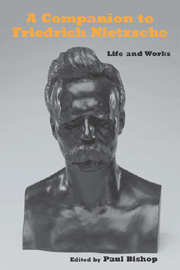Book contents
- Frontmatter
- Contents
- Acknowledgments
- A Note on Editions and Abbreviations
- Introduction
- Link to Nietzsche's Early Writings
- Link to The Birth of Tragedy
- Link to Untimely Meditations
- Link to Human, All Too Human
- Link to Daybreak
- Link to The Gay Science
- Link to Zarathustra
- 7 Thus Spoke Zarathustra
- Link to Beyond Good and Evil
- Link to On the Genealogy of Morals
- Link to The Case of Wagner and Nietzsche contra Wagner
- Link to Twilight of the Idols, The Anti-Christ, and Ecce Homo
- Link to the Nachlass
- Conclusion
- Notes on the Contributors
- Index
7 - Thus Spoke Zarathustra
from Link to Zarathustra
Published online by Cambridge University Press: 05 February 2013
- Frontmatter
- Contents
- Acknowledgments
- A Note on Editions and Abbreviations
- Introduction
- Link to Nietzsche's Early Writings
- Link to The Birth of Tragedy
- Link to Untimely Meditations
- Link to Human, All Too Human
- Link to Daybreak
- Link to The Gay Science
- Link to Zarathustra
- 7 Thus Spoke Zarathustra
- Link to Beyond Good and Evil
- Link to On the Genealogy of Morals
- Link to The Case of Wagner and Nietzsche contra Wagner
- Link to Twilight of the Idols, The Anti-Christ, and Ecce Homo
- Link to the Nachlass
- Conclusion
- Notes on the Contributors
- Index
Summary
Introduction
“AMONG MY WRITINGS my Zarathustra stands alone” (Innerhalb meiner Schriften steht für sich mein Zarathustra; EH preface §4; KSA 6, 259). But Nietzsche never thought that Thus Spoke Zarathustra (Also sprach Zarathustra) should be studied alone. While it is strikingly unique, it fulfills and extends the relatively more conventional books that preceded it and is supplemented by those that followed it. It stands alone because Nietzsche chose a unique vehicle to introduce a unique thought, one that came to him suddenly but only as a consequence of the gathering understanding acquired across decades of study and writing. The oddness of that thought and the change it signified in the human disposition toward things required a unique introduction. Thus Spoke Zarathustra stands alone as the introduction to Nietzsche's thought of eternal return.
“I have not been asked, as I should have been asked, what ‘Zarathustra’ means in my mouth” (Man hat mich nicht gefragt, man hätte mich fragen sollen, was gerade in meinem Munde […] der Name Zarathustra bedeutet; EH “Why I Am a Destiny” §3; KSA 6, 367). When Nietzsche wrote this four years after completing his Zarathustra, he explained what it meant. “Zarathustra” was the name of the Persian prophet who first viewed time as history, the locus of a continuous struggle between good and evil that would culminate at the end of history in an apocalyptic victory for the good, assigning good human beings an eternity of well-being and evil ones an eternity of suffering. Who is Zarathustra in Nietzsche's mouth?
- Type
- Chapter
- Information
- A Companion to Friedrich NietzscheLife and Works, pp. 201 - 226Publisher: Boydell & BrewerPrint publication year: 2012



